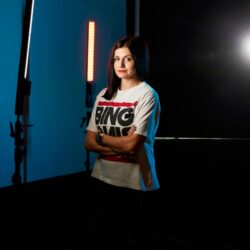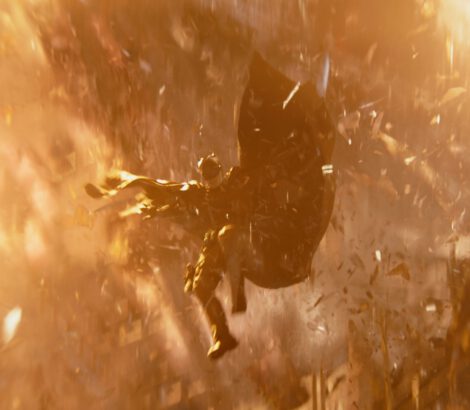
Scanline VFX from Munich: Award-winning visual effects
Founded in 1989 in the Bavaria Filmstadt in Munich, Scanline VFX is today one of the world market leaders in the field of visual effects for film, television and streaming. Groundbreaking innovations are conceived and realized here. An interview with Vice President Jasmin Hasel.
She has a good chance of being nominated as the coolest vice president of a company that is one of the world's leading VFX houses: Jasmin Hasel spreads good vibes from the first moment she arrives in Scanline's conference room on the grounds of the Bavaria Film Studios in Munich. The 40 year old manager is a dynamic doer who is respected by Hollywood's top directors. At the same time, she is approachable, humorous and without airs and graces. A quick double espresso to wake up, and then the first question:
Ms. Hasel, Scanline VFX has a long history of operating abroad. Are you just coming back from the big wide world?
Jasmin Hasel: On the contrary, I literally arrived from the small world this morning. At the beginning of the Corona pandemic, I moved to the countryside, where I now run a small hobby farm with my partner. It is quite different from my job, because I keep bees, chickens, sheep and four goats there.
What were the incentives for establishing Scanline, which is now shaking up Hollwood, in the city of Munich in 1989?
Hasel: Well, the founders of Scanline, Thomas Zauner and Stefanie Stalf, live here. And Munich has always been a city of films. Producers and creatives lived and still live here. There is also a bit of positive craziness. In the sense that people have the courage to try something new. And film funding also recognized the importance of visual effects in film at an early stage. As a result, the FFF Bayern made service provider funding possible in our field, as was also the case in Canada, for instance. This made us competitive and we were able to train and retain top people in Germany, as well as attract additional professionals to Germany.
Scanline: Hollywood Breakthrough with New Software
What development did Thomas Zauner foresee back then?
Hasel: When Scanline was launched in 1989, it was technically possible for the first time to implement complex photorealistic effects in post-production digitally on the computer. At the time, that was a revolution! After starting with industrial films and logo animations, Scanline received its first VFX request in mid-1996 from SWR for a crime scene with Lena Odenthal. The title was "Death in Space". A water tower in the forest was to be transformed into a UFO. This was the first big visual effects job for Scanline.
And it was the starting signal for the fast and remarkable success?
Hasel: Yes, because a year later we received an inquiry from Sat.1 for the series "HeliCops – Einsatz über Berlin". It was about using helicopters digitally. And it continued with "Hai-Alarm auf Mallorca". An RTL summer movie, for which it was necessary to create water simulations as well as scenes of the shark underwater.
A momentous order for Scanline.
Hasel: That's right, because dealing with the water environment inspired our supervisor at the time and current company CEO Stephan Trojansky to develop Flowline. This was the first Fluid Dynamic software program that made it possible to virtually create elaborate film scenes on and under water down to the smallest detail. At the time, there was no conventional software available for this type of shooting. In other words, everything was programmed and realized in-house at Scanline. Flowline was way ahead of the curve back then. We were the only ones in the world who could create visual effects so extremely photorealistic and individual.
Was Flowline the golden ticket to Hollywood?
Hasel: Definitely on a grand scale. Because that's how Wolfgang Petersen became aware of us and had Scanline work on the blockbuster "Poseidon" in 2006. This was followed by another request from Hollywood to do five shots for the comic book adaptation "300" by Zack Snyder. "If they’re not good enough, they're not in the movie", we were told. But they made it into the movie. The final breakthrough in Hollywood came in 2008, when Flowline won an Academy Award for scientific and technical achievement. This brought Scanline to the attention of Clint Eastwood, who worked with us in 2010 to design the film "Hereafter", which featured major tsunami scenes. We were also nominated for an Oscar in 2011 for "Best Visual Effects" for our work.
Bavaria’s location advantages exceed
Scanline now has international production offices in Los Angeles, Montreal, Vancouver, London and Seoul. Why does the Munich location still play a decisive role?
Hasel: We are still well connected with German producers. Bully (*Herbig), for example, has always been one of our main customers. I have learned a lot from him since I started at Scanline in 2008 and we produced "Wickie und die starken Männer'' together. Bully recognized the importance of VFX very early. Because visual effects will no longer be an issue for post-production in the future. You have to sit down with equipment, camera and SFX stunt teams during planning already and consider how to effectively solve challenges. Bully does that. He writes an exposé and initial scripts, sends them to us and then asks for an assessment: Is this possible or is it too complicated or expensive? Do I have to rewrite something? He has done a lot of innovative work in this field.
Does Scanline also work with the renowned University of Television and Film in Munich?
Hasel: Yes, the HFF is certainly a great location advantage. There are always collaborations and we are happy when film school students do an internship with us. By the way, that's how I got my job. At the time, however, I was studying at the Stuttgart Media University, which Scanline also has close ties with.
Is it currently difficult to find suitable employees for the Munich site?
Hasel: A lot has changed in recent years. In the past, talented people who trained with us moved to New Zealand and Canada because the big, well-paid jobs were there. We now have international contracts in Munich and can keep top people here. In addition, the excellent quality of life attracts many international employees to Munich.
What international productions is Scanline currently involved in?
Hasel: In 2022, the films "The Gray Man" and "Slumberland", in which we were involved, were released. We will also be contributing significant VFX scenes for the blockbusters "Aquaman 2" and "Meg 2". And we have big things planned with Netflix, but I can't talk about them specifically yet.
AI, machine learning and LEDs make their way into studios
What is the current trend in visual effects?
Hasel: Growth and development in the industry are happening at a rapid speed. The Corona boom was another booster for new technologies, including production in LED stages instead of in front of a green screen. For example, you shoot the plates in Iceland and then have them as a background in the studio. That way, you can also shoot the actors separately and then merge them with the background. Digital backgrounds are also built and provided in advance. Many studios now even work with LED floors and ceilings, which is totally awesome.
Do LED stages also have a future in terms of sustainability?
Hasel: They will certainly play a major role. This is due to the fact that many services and travels can be eliminated. You no longer have to transport large crews from A to B, but can minimize the sets via the LED studios. Ultimately, this will certainly benefit the CO2 balance.
And what innovations is Scanline working on?
Hasel: Computer learning processes and artificial intelligence will play an increasingly important role in the future. And also automated processes that make everything even faster and more efficient. Our computers are being trained more and more to learn motion sequences and transfer them to other objects, especially for animations.
World market leader Netflix relies on Scanline technology
Scanline VFX was acquired by Netflix in 2021. How did that come about?
Hasel: We are honored that such a successful company like Netflix wanted us as an addition. We've been working with Netflix for a long time. Our first order, "Stranger Things", season 3, got an Emmy nomination right away. That was a good start. There is an intense partnership as well as extensive creative exchange. In times when content is so important, it's even more essential for Netflix to secure resources and know-how. And that's what the company has done with its purchase of Scanline. However, Netflix continues to work with other studios and so do we. It is crucial for our artists to maintain diversity.
The Flowline software program won a technology Oscar in 2008. Have you ever been to the Academy Awards?
Hasel: In 2022, I was actually allowed to be there once, because Scanline was also nominated for "Free Guy". On the way there, I told CEO Stephan Trojansky, "If I meet Steven Spielberg today, I'm retiring." Then I actually met him, and he was very friendly and cordial. That was the highlight of the evening for me. But I'll keep working for a few more years before retiring.
Glossary: Technical terms in the art form of visual effects.
VFX: Visual effects that are created on a digital basis.
SFX: Special effects that are realized on set during filming.
SFX Stunt: Stunt scenes that take place (usually in combination with special effects) in real life on the set.
Fluid Rendering System: with Flowline, Scanline developed the first software program worldwide which digital water and underwater simulations could be built with.
VFX Artist: VFX artist or collaborator who digitally creates visual effects on the computer.
LED Stage: A light dome with billions of LEDs. It allows real environments or virtual worlds to be photorealistically projected.
Plates: Film material that is intended as an element in a composite shot for visual effects. Plates often consist of locations or backdrops that are used as backgrounds or for other elements as needed.
Object trick: Animation of three-dimensional objects in a depth-of-field-sensitive space.
Bannerbild: Scanline VFX studio: The Netflix blockbuster "Don't Look Up" convinced with tremendous images from Munich. Photo: Scanline VFX







